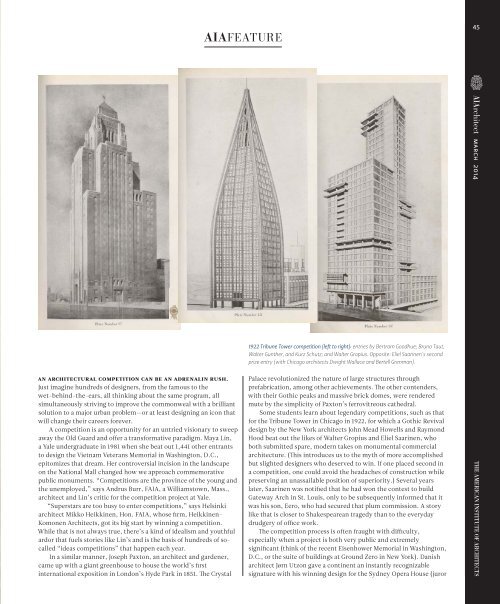Architect 2014-03.pdf
Create successful ePaper yourself
Turn your PDF publications into a flip-book with our unique Google optimized e-Paper software.
AIAFEATURE<br />
45<br />
march <strong>2014</strong><br />
1922 Tribune Tower competition (left to right): entries by Bertram Goodhue; Bruno Taut,<br />
Walter Gunther, and Kurz Schutz; and Walter Gropius. Opposite: Eliel Saarinen’s second<br />
prize entry (with Chicago architects Dwight Wallace and Bertell Grenman).<br />
an architectural competition can be an adrenalin rush.<br />
Just imagine hundreds of designers, from the famous to the<br />
wet-behind-the-ears, all thinking about the same program, all<br />
simultaneously striving to improve the commonweal with a brilliant<br />
solution to a major urban problem—or at least designing an icon that<br />
will change their careers forever.<br />
A competition is an opportunity for an untried visionary to sweep<br />
away the Old Guard and offer a transformative paradigm. Maya Lin,<br />
a Yale undergraduate in 1981 when she beat out 1,441 other entrants<br />
to design the Vietnam Veterans Memorial in Washington, D.C.,<br />
epitomizes that dream. Her controversial incision in the landscape<br />
on the National Mall changed how we approach commemorative<br />
public monuments. “Competitions are the province of the young and<br />
the unemployed,” says Andrus Burr, FAIA, a Williamstown, Mass.,<br />
architect and Lin’s critic for the competition project at Yale.<br />
“Superstars are too busy to enter competitions,” says Helsinki<br />
architect Mikko Heikkinen, Hon. FAIA, whose firm, Heikkinen-<br />
Komonen <strong>Architect</strong>s, got its big start by winning a competition.<br />
While that is not always true, there’s a kind of idealism and youthful<br />
ardor that fuels stories like Lin’s and is the basis of hundreds of socalled<br />
“ideas competitions” that happen each year.<br />
In a similar manner, Joseph Paxton, an architect and gardener,<br />
came up with a giant greenhouse to house the world’s first<br />
international exposition in London’s Hyde Park in 1851. The Crystal<br />
Palace revolutionized the nature of large structures through<br />
prefabrication, among other achievements. The other contenders,<br />
with their Gothic peaks and massive brick domes, were rendered<br />
mute by the simplicity of Paxton’s ferrovitreous cathedral.<br />
Some students learn about legendary competitions, such as that<br />
for the Tribune Tower in Chicago in 1922, for which a Gothic Revival<br />
design by the New York architects John Mead Howells and Raymond<br />
Hood beat out the likes of Walter Gropius and Eliel Saarinen, who<br />
both submitted spare, modern takes on monumental commercial<br />
architecture. (This introduces us to the myth of more accomplished<br />
but slighted designers who deserved to win. If one placed second in<br />
a competition, one could avoid the headaches of construction while<br />
preserving an unassailable position of superiority.) Several years<br />
later, Saarinen was notified that he had won the contest to build<br />
Gateway Arch in St. Louis, only to be subsequently informed that it<br />
was his son, Eero, who had secured that plum commission. A story<br />
like that is closer to Shakespearean tragedy than to the everyday<br />
drudgery of office work.<br />
The competition process is often fraught with difficulty,<br />
especially when a project is both very public and extremely<br />
significant (think of the recent Eisenhower Memorial in Washington,<br />
D.C., or the suite of buildings at Ground Zero in New York). Danish<br />
architect Jørn Utzon gave a continent an instantly recognizable<br />
signature with his winning design for the Sydney Opera House (juror


















